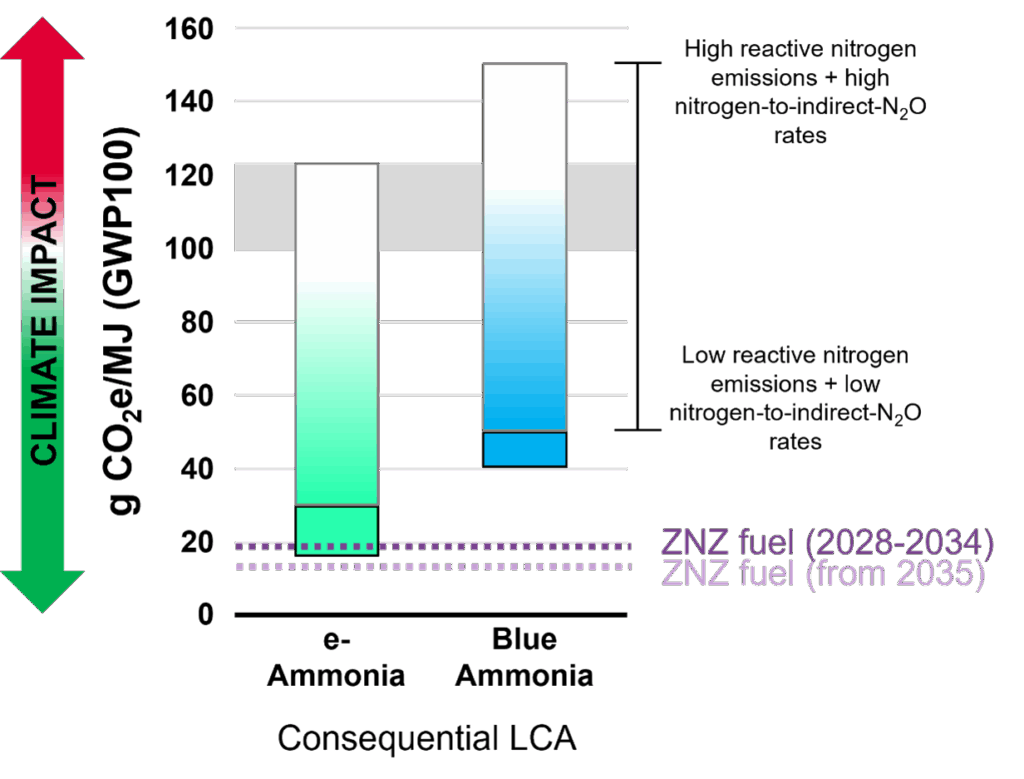Clarifying the environmental impacts of ammonia as a shipping fuel: A call for deeper unde
May 28, 2025
- Ammonia is under consideration as a near-zero-emission fuel to help the shipping sector transition away from fossil fuels. But because the fuel’s lifecycle emissions profile is complex, its impacts need to be better understood and effectively managed.
- Findings from two recent studies build on how ammonia’s emissions from production, combustion and across the value chain influence ammonia’s climate impact — and why managing them is crucial to delivering real climate benefits while safeguarding people and the environment.
The International Maritime Organization has approved a global fuel standard that accounts for greenhouse gas emissions across a fuel’s full lifecycle—including production, distribution, storage, and end use. This new standard, subject to adoption in October, will require marine fuels to meet progressively lower lifecycle GHG thresholds and help the shipping sector reach its decarbonization goals.
Ammonia (NH3) is under consideration as a near-zero-emission fuel to help the shipping sector transition away from fossil fuels. When combusted, ammonia emits no carbon dioxide (CO2) or other carbon-based climate pollutants like methane. However, its lifecycle emissions profile is far more complex. Producing ammonia is emissions-intensive, and its handling and end use can emit non-carbon pollutants that contribute to climate warming, degrade air quality and harm ecosystems.
Clarifying the environmental impacts of ammonia as a shipping fuel: A call for deeper understanding and effective management Share on X
Ammonia could help the shipping sector cut emissions — but only if its full lifecycle impacts are understood and effectively managed. That includes emissions from production and combustion, and ammonia emissions across the value chain. As the IMO finalizes its fuel standard, I share findings from two recent studies that build our understanding of how these emissions influence ammonia’s climate impact — and why managing them is crucial to delivering real climate benefits while safeguarding people and the environment.
The promise and challenges of ammonia
Ammonia can be produced through several methods, each with different emissions profiles. The conventional process for ammonia production relies on hydrogen derived from natural gas or coal, making the fuel highly polluting when produced this way. Fossil-based (gray) ammonia accounts for over 1.2% of global GHG emissions, roughly equivalent to the annual emissions of 150 million cars.
Alternative methods, such as blue ammonia (produced with carbon capture and storage) and e-ammonia (produced using renewable energy), aim to reduce emissions. While e-ammonia has the potential for near-zero emissions when its production process is entirely powered by renewables and with minimal hydrogen emissions (including leakage and venting), blue ammonia’s climate impact depends on capturing carbon effectively and minimizing both methane and hydrogen emissions.
But reducing GHG emissions from production alone is insufficient to ensure that ammonia will be a near-zero-emission fuel. Ammonia combustion — when ammonia is burned in the ship’s engine — results in reactive nitrogen emissions, including nitrous oxide (N2O), nitrogen oxides (NOx) and unburned ammonia (NH3 slip). While NOx and NH3 contribute to air pollution, N2O is a powerful GHG that is 273 times more potent than carbon dioxide and lingers in the atmosphere for over 120 years. So, besides carbon emissions, nitrogen emissions must also be considered to accurately assess ammonia’s suitability as a marine fuel.
The lifecycle analysis: A nearly complete view
A recent lifecycle assessment study led by Maersk and conducted by Danish consultancy LCA 2.0, Life Cycle Assessment of Ammonia Fuel, with input from nine partners, including Environmental Defense Fund, evaluated ammonia’s climate and environmental impact, accounting for production emissions and reactive nitrogen emissions from combustion (i.e., N2O, NOx, and NH3.) The study compared e-ammonia and blue ammonia, combusted with pilot fuel, to very low sulfur fuel oil, the fuel commonly used in ships today.
The LCA found that:
- e-ammonia from wind or solar power — with minimal hydrogen and ammonia emissions (0.3%) — can reduce lifecycle GHG emissions by around 80% compared to VLSFO.
- Blue ammonia — with a 90% carbon capture rate and minimal methane, hydrogen and ammonia emissions (0.3%) — achieves around 60% emissions reductions compared to VLSFO.
- Ammonia as a marine fuel could negatively affect aquatic and terrestrial ecosystems (by 35 – 65% more than VLSFO), raising environmental concerns beyond its impact on climate.
Figure 1. Ammonia’s lifecycle climate impact compared to very-low sulfur fuel oil and the zero- and near-zero fuel thresholds1 that were agreed in April 2025 during the Marine Environment Protection Committee (MEPC) 83rd meeting.
[1] ZNZ emission thresholds: 19.0 g CO2e/MJ (a metric accounting for the total amount of carbon-dioxide-equivalents released per energy provided by the fuel) until the end of 2034 and <14.0 g CO2e/MJ thereafter.
The overlooked impact of indirect N2O emissions
But ammonia’s climate impact extends beyond direct emissions from production and combustion. Ammonia can be released at various points across the value chain—through leaks, spills, and operational venting of boil-off or evaporated gas—contributing to additional climate risks. Once in the environment, ammonia undergoes chemical and biological transformations that produce N2O and other reactive nitrogen emissions. Likewise, the nitrogen oxides (NOx) emitted during combustion can also convert into N2O. Beyond climate impacts, ammonia and NOx emissions can degrade air quality and harm ecosystems.
Most studies overlook indirect N2O emissions, but the LCA study cited above did account for them, albeit using a low conversion rate of 0.3% and in an additional (or sensitivity) analysis. The conversion rate remains uncertain, but it may be higher in some environments. Agricultural studies suggest that between 0.1% and 21% of ammonia-based nitrogen can convert to N2O, depending on factors like temperature and oxygen concentration. Additionally, airborne ammonia emissions can react with atmospheric chemicals, further contributing to global N2O emissions. More research is needed to better constrain these conversion rates in marine environments and accurately assess the climate impact of ammonia as a marine fuel.
Closing the gap: modeling the climate impact of reactive nitrogen emissions
To fully assess ammonia’s climate impacts, EDF developed a model to provide a more complete view of the impact of both direct and indirect N2O emissions across the ammonia marine fuel value chain, including production, compression or liquefaction, distribution, storage, bunkering, and combustion. This model incorporates N2O, NOx, and NH3 emissions at each value chain stage under different scenarios, ranging from low to high emissions, and with various nitrogen-to-indirect-N2O conversion rates.
The study, Climate Impact of Direct and Indirect N2O Emissions from the Ammonia Marine Fuel Value Chain, published in Environmental Science & Technology, used the model to evaluate how reactive nitrogen emissions affect ammonia’s climate impact.
We found that:
- Minimizing N2O, NOx, and NH3 emissions is crucial to ensuring ammonia contributes to climate mitigation efforts.
- High reactive nitrogen emissions can completely negate ammonia’s potential climate benefits and even lead to higher emissions than fuel oils if nitrogen-to-indirect-N2O conversion rates are high (e.g., above 5%).
- Only under a low reactive nitrogen emission scenario can e-ammonia achieve 70–80% lifecycle GHG emission reductions compared to fuel oils.
- Blue ammonia, at best, achieves a 30% emissions reduction and could result in higher GHG emissions than fuel oil if nitrogen emissions or nitrogen-to-indirect-N2O conversion rates are high.
Figure 2. Ammonia’s well-to-wake climate impact reported in the LCA study, including a wide range of reactive nitrogen emissions—NH3 and NOx—and nitrogen-to-indirect-N2O conversion rates (0 – 10%).
Policy implications: Solutions to maximize ammonia’s climate benefits
Come October, the IMO must adopt a lifecycle approach to regulate marine fuels. Its global fuel standard should account for all direct and indirect GHG emissions, including carbon dioxide, methane, hydrogen, nitrous oxide and other reactive nitrogen emissions, like ammonia.
Currently, no alternative fuel is a silver bullet to decarbonize shipping. E-ammonia holds promise as a near-zero-emission shipping fuel; but its climate benefits will depend on strict measures to mitigate emissions across the value chain. These measures include reducing production emissions (e.g., by using clean electricity and increasing process efficiency), mitigating reactive nitrogen emissions from combustion (e.g., through exhaust treatment technologies or fuel cells), and minimizing hydrogen and ammonia emissions across the value chain.
The IMO now has the responsibility to ensure that alternative fuels deliver genuine climate benefits while preventing unintended consequences for the environment and communities.
Related Posts
Search
RECENT PRESS RELEASES
Related Post







